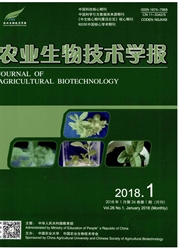

 中文摘要:
中文摘要:
斑茅在甘蔗育种的利用是现代甘蔗育种种质创新的热点,育种者期望把斑茅中优异的特性通过杂交渗透到甘蔗中。甘蔗与斑茅的F1是斑茅利用研究的难点也是基础。本研究利用基因组原位杂交技术(GISH)分析甘蔗与斑茅的F1染色体构成和核型,探讨甘蔗与斑茅F1染色体的遗传行为。GISH结果表明,甘蔗与斑茅杂交F1的染色体众数68-69条,其中40条来自甘蔗热带种Badila,28-29来自海南斑茅,未发现有染色体的交换或易位现象。参试材料大部分染色体都属于中部着丝点(m)的染色体,少数为近中部着丝点(sm),YCE95-41核型属2B型,其余的核型都属为1B型。甘蔗与斑茅的染色体按n + n的方式传递给F1,本研究结果为斑茅种质在甘蔗育种中的利用及其杂交后代染色体细胞遗研究提供参考依据。
 英文摘要:
英文摘要:
Utilization of Erianthus arundinaceus is a hot topic in modern sugarcane germplasm innovation program. Sugarcane breeders expect to permeate excellent characteristics of Erianthus arundinaceus into Saccharum through intergeneric cross. The F1 hybrids perform a base and importance role in studying and utilization of Erianthus arundinaceus. In this study, chromosomes of F1 hybrids between Saccharum officinarum and Erianthus arundinaceus were studied by genomic in situ hybridization (GISH) to discover chromosome genetic behavior of F1 hybrids. The results of GISH revealed that F1 hybrids chromosome showed a total of 68 to 70 chromosomes, of which 40 were derived from Badila (Saccharum officinarum) and 28 to 30 were derived from Hainan Erianthus arundinaceus. Chromosome translocation and exchange were not found. Most of chromosomes belong to median centromere type (m) and few of chromosomes belong to submetacentromere type (sm) in 5 F1 clones, the karyotype is 1B or 2B. The results revealed that 5 F1 clones were product of n n transmission. These results may serve as chromosome genetic basis of the hybrid progeny for utilization of Erianthus arundinaceus germplasm in sugarcane breeding program.
 同期刊论文项目
同期刊论文项目
 同项目期刊论文
同项目期刊论文
 期刊信息
期刊信息
